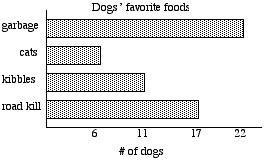
Unit 2 Module 8
Statistical Graphs, Charts, Tables, Percentages
EXAMPLE 2.8.1
The bar graph below shows the results of a survey in which a number of dogs were asked "What is your favorite food?" No dog gave multiple answers.

What percent of dogs said that their favorite food was cats?
A. 6%
B. 17%
C. 11%
D. 30%
EXAMPLE 2.8.1 SOLUTION
First, we find the number of dogs who responded to the survey. We do this by recognizing that the numbers on the horizontal axis tell how many dogs gave each of the four responses. If we add those four numbers, we have the total number of dogs who responded:
6 + 11 + 17 + 22 = 56
There were 56 dogs who responded to the survey (we say that in this survey the sample size or sample population is 56, or simply that n = 56).
Now we read the graph and see that 6 of the 56 dogs gave the response "cats." Thus, we need to find the percentage that corresponds to "6 out of 56." To do this, we divide 6 by 56, and then multiply by 100%.

= 10.7%
The best choice is C.
Notice that when we "multiply 0.107 by 100%" what we actually do is move the decimal point two places to the right, and include a "%" sign.
FACT: To convert a decimal number to a percent, we move the decimal point two positions to the right, and add a percentage sign.
EXAMPLE 2.8.2
The graph below shows the distribution according to academic major of a group of students. None of them have double majors.
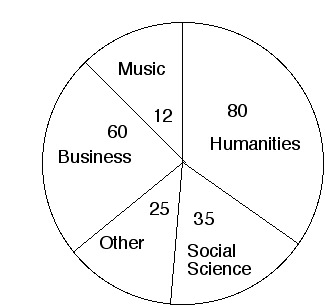
Approximately what percent are majoring in something other than music?
A. 25%
B. 12%
C. 88%
D. 94%
EXAMPLE 2.8.3
The graph below shows the percentage distribution of grades on an exam.
Assuming that 828 people took the test, how many received grades of A or B?
EXAMPLE 2.8.4
The graph below shows information about US households over the period of time beginning in 1910 and ending in 1990. Suppose that the US population in 1990 was roughly 270 million. How many people were classified as "rural."
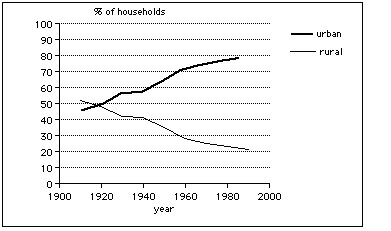
EXAMPLE 2.8.5
The graph below shows the projected assets of the Social Security Trust Fund over the period of time beginning in 1997 and ending in 2032. Based on these projections, decide whether each statement is true or false.
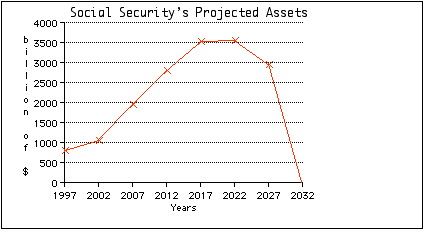
A. The assets will be positive over the entire period of time.
B. The assets will be increasing over the entire period of time.
C. Over the period of time from 2022 to 2027, the Social Security Trust Fund will be in debt.
D. The rate at which the assets increase will be greatest over the period from 2002 to 2007.
E. Over the period from 2007 to 2030 the assets will decrease by about $1000 billion.
SCATTER DIAGRAMS
A scatter diagram is a plot that uses a number of individual cases to display the relationship between two variable quantities.
EXAMPLE 2.8.6
The scatter diagram below shows the relationship between the number of absences from lecture and the Unit 1 test score for students in one section of Liberal Arts Mathematics during spring semester, 1999. Determine whether each of the statements given below is true or false.
1. The students with the two lowest scores had the greatest number of absences. True or false?
2. Increased numbers of absences are always associated with lower test scores. True or false?
3. Among students with at least 4 absences, the highest test score was about 70. True or false?
4. Students who had zero absences tended to do better than the other students. True or false?
5. Skipping class causes students to get lower test scores. True or false?
6. Among students with fewer than 2 absences, only one failed to get a test score of at least 60%. True or false?
EXAMPLE 2.8.7
This graph shows the relationship between high school GPA and college GPA for a certain group of students.
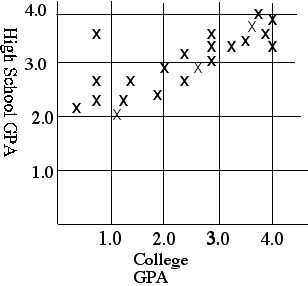
Select the statement that is correct, according to the data shown.
A. Higher high school GPAs tend to be associated with higher college GPAs.
B. Higher college GPAs tend to be associated with lower high school GPAs.
C. Higher high school GPAs cause higher college GPAs.
D. There is no apparent association between college GPA and high school GPA.
MISLEADING GRAPHS
EXAMPLE 2.8.8
The graph below shows the US unemployment rate (as a percentage) on a month-by-month basis over the period of time beginning in January 1998 and ending in January 1999.
True or false: The unemployment rate in September 1998 was roughly twice as great as the unemployment rate in May 1998.
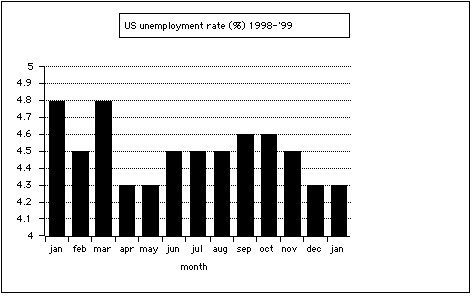
EXAMPLE 2.8.8 SOLUTION
The statement is false. Although the column above "sep" appears twice as high as the column above "may," the visual depiction is misleading due to the fact that numbers on the vertical axis begin at 4, rather than at 0. In other words, this graph is incomplete: it is only showing us the "treetops" rather than showing the whole forest. The complete graph, drawn to scale, looks like this:
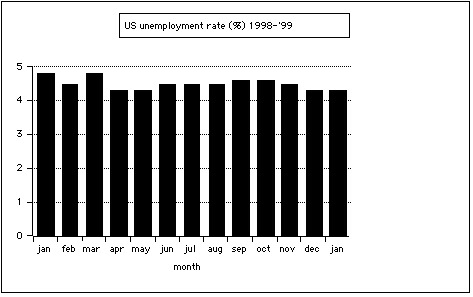 As this graph shows, there is relatively little difference between the unemployment rates in the two months. The misleading graph that was used first did not show the whole picture, and hence the differences were greatly exaggerated. This kind of distortion is not unusual; it is frequently employed be people who are trying to use statistics to convey an inaccurate impression.
As this graph shows, there is relatively little difference between the unemployment rates in the two months. The misleading graph that was used first did not show the whole picture, and hence the differences were greatly exaggerated. This kind of distortion is not unusual; it is frequently employed be people who are trying to use statistics to convey an inaccurate impression.
EXAMPLE 2.2.9
Gomer recently took a job as a telemarketer. His first month's (January) sales were dismal. His sales figures for his second month were better: his February sales were twice as great as his January sales. To convey that point, he showed this graph to his boss. What is wrong with the graph?
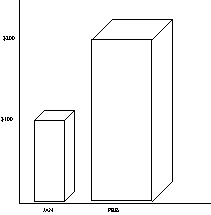
EXAMPLE 2.2.9 SOLUTION
In this case (unlike in the previous example), the vertical scale starts at 0, as it should. Also, the heights of the two figures are drawn correctly to scale, since the column above "FEB" is twice as high as the column above "JAN." What makes this graph misleading is that fact that Gomer is incorrectly using a three-dimensional object (a column in the shape of a rectangular solid) to represent a one-dimensional quantity.
Assume that the column above "JAN" correctly depicts sales for January. Notice that the column above "FEB" is twice as high, twice as wide and twice as deep as the column above "JAN." This means that the column above "FEB" is actually 8 times as large as the column above "JAN."
If Gomer wanted to use three-dimensional objects like these to accurately depict the relationship between January sales and February sales, then the second column could be twice as high as the first, OR twice as wide as the first, OR twice as deep as the first, but it can't be all of these things.
Percent increase or percent decrease
If a quantity increases or decreases, we can compute the percent increase or percent decrease.
Percent increase
If a quantity is increasing, we compute percent increase as follows:
![]()
This is the same as:

Percent decrease
If quantity is decreasing, we compute percent decrease as follows:
![]()
Which is the same as:

EXAMPLE 2.8.10
In July, Gomer had 12 pet wolverines and 10 fingers. In August, he had 15 pet wolverines and 8 fingers.
1. Find the percent increase in his wolverines.
A. 25%
B. 125%
C. 30%
D. 3%
2. Find the percent decrease in his fingers.
A. 80%
B. 180%
C. 20%
D. 120%
see solution
EXAMPLE 2.8.11
(The information in this example is factual, according to the Workers Rights Council.)
1. In a sweatshop in El Salvador, a seamstress is paid 74¢ for the labor required to sew one Liz Claiborne jacket (retail price: $198). If she were to be paid a "living wage," her pay would for that job would increase to $2.64. Find the percent increase in her pay if this were to happen.
2. Referring to the information in Part 1:
Suppose that the seamstress' pay is increased so that she receives a "living wage," and suppose that the entire cost of this is passed on to the consumer. Find the percent increase in the retail cost of the jacket.